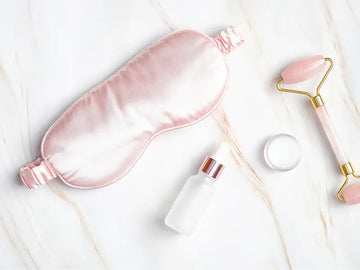
As we delve into the intricacies of skin cycling, we come to appreciate the critical role of recovery in this revolutionary skincare approach. At Videri Beauty Boutique, we're dedicated to guiding you through each phase of the skin cycling process, with special emphasis on the nights dedicated to recovery—a vital component for achieving a glowing, healthy complexion.
In our insightful blog post, we focus on the skin cycling recovery night, an essential pause that allows your skin to rest and rejuvenate after active treatments. Understanding the importance of giving your skin a break is key to enhancing its natural healing abilities and ensuring that your active skincare regimen delivers the best results without overwhelming your skin.
Join us as we explore the best practices for recovery nights, including the types of products to use, the benefits of allowing your skin to breathe, and how to listen to your skin's unique needs. Whether you're a beginner or looking to optimize your current skin cycling routine, our article will provide you with the knowledge to master the art of recovery for a radiant and refreshed complexion. Let's embrace the power of rest and repair in our skincare journey together!
What is Skin Cycling Recovery Night?
Skin Cycling Recovery Night is a systematic approach to skincare that focuses on the body's natural regenerative processes during the night.
This method is designed to harness the skin's innate ability to repair and rejuvenate itself while we sleep.
The below infographic shows where this 'recovery night' steps are located on the skin cycling routine.

Definition:
Skin Cycling Recovery Night is a structured skincare routine rotating between different active ingredients or products. The goal is to optimize skin health without overburdening it.
This rotation ensures that the skin gets the benefits of various ingredients without the risk of irritation or overuse.
Science Behind Night-time Regeneration:
Our skin undergoes a significant transformation at night.
Cellular repair processes are more active, and the skin becomes more receptive to active ingredients. This is primarily due to the body's circadian rhythms, which dictate various physiological processes, including skin regeneration.
According to experts like Kendra Flockhart, education executive at Darphin, and Dr. Anna Persaud, CEO at This Works, the skin switches into ‘recovery mode’ during sleep. This is a time of intense repair and regeneration.
In fact, the regeneration process can be up to three times faster at night than during the day.
The skin starts its wind-down process around 9 p.m., entering what is known as the evening phase. This phase is crucial for DNA repair and the absorption of topical treatments.
The sleep hormone melatonin begins to rise a few hours before bedtime, enhancing our feeling of tiredness and increasing our skin’s ability to repair itself. Melatonin counteracts damage to the skin during the day from aggressors like UV rays and pollution.
Another hormone that becomes active during sleep is HGH (the human growth hormone). This hormone accelerates skin repair and cell regeneration. Between 11 p.m. and 4 a.m., cell production can double, and during deep sleep, cell turnover can increase threefold.
Key Components:
Exfoliation: This helps remove dead skin cells, allowing for better absorption of other products and promoting the growth of new, healthy skin cells.
Hydration: Nighttime is when the skin can lose a lot of its moisture. Using hydrating products can help counteract this loss and ensure the skin remains plump and hydrated.
Active Ingredients: Ingredients such as retinol boost collagen production and encourage epidermal cell renewal. Hyaluronic acid deeply hydrates the skin, reducing the effects of overnight water loss.
Essential Oils: Oils like those from Darphin provide nourishment, hydration, and suppleness to the skin. They also offer aromatherapy benefits that can aid in better sleep, allowing for optimal skin recovery.
The infographic is showing you these steps graphically below.

The Importance of Night-time Skin Recovery
Nighttime is a pivotal period for our skin. As we rest, our skin shifts gears, transitioning from its daytime defensive mode to a more reparative and regenerative state.
This shift is not just a mere change in skin behavior but is deeply rooted in our body's biological processes and the skin's intrinsic need to heal and rejuvenate.
Different Behavior at Night:
During the day, our skin primarily focuses on protecting itself from external aggressors like UV rays, pollution, and other environmental factors.
However, at night, the skin's priority is repair and recovery. This shift is evident in the increased cellular turnover and the enhanced absorption rate of skincare products applied during the evening.
Erum N. Ilyas, MD, MBE, FAAD, highlights that signs of tiredness, such as dry skin, hollowing of cheeks, and dark under-eye circles, often result from dehydration that accompanies fatigue.
This dehydration is not just due to inadequate water intake but is also influenced by sleep patterns.
The Role of Circadian Rhythms:
Circadian rhythms are natural, internal processes that regulate the sleep-wake cycle and repeat roughly every 24 hours.
These rhythms influence skin health, dictating factors like moisture levels, cell regeneration, and the production of certain skin-related hormones.
The skin, like our entire body, has its own circadian rhythm. It shifts between protection during the day and repair at night. This natural renewal process is at its peak during nighttime, making it the optimal period for skincare interventions.
Benefits of Nighttime Recovery:
- Collagen Production: Sleep promotes the production of collagen, a protein responsible for skin elasticity and firmness. A lack of sleep can lead to reduced collagen, resulting in fine lines and wrinkles.
- Hydration: As we sleep, our skin's hydration rebalances. The skin is able to recover moisture, while excess water in general is processed for removal. Not getting enough sleep can lead to poor water balance, leading to puffy bags under the eyes and dryness.
- Combating Signs of Aging: A good night's sleep can help reduce the appearance of fine lines on the skin. It also helps prevent acne breakouts, skin sensitivity, and allergic contact dermatitis reactions. Being well-rested can make immune-related skin problems flare up less often.
- Enhanced Product Absorption: The skin's permeability is higher at night, meaning creams and serums are absorbed better and can, therefore, have a greater impact.
When to Practice Skin Cycling Recovery Night
Timing and frequency are paramount when it comes to the practice of Skin Cycling Recovery Night. The skin's natural processes and the products we use play a significant role in determining the best time and frequency for this routine.
Frequency: Every Night vs. Alternate Nights
While some skincare enthusiasts swear by nightly routines, others find that an alternate night approach works best for them. The decision largely depends on individual skin type and tolerance levels. For instance:
- Oily Skin: Those with oily skin might benefit from a more frequent application of certain products to control sebum production.
- Sensitive Skin: On the other hand, individuals with sensitive skin might need to space out their use of potent ingredients to prevent irritation and over-exfoliation.
Starting Time: Pre-Bedtime Routine
It's recommended to start your Skin Cycling Recovery Night routine a few hours before bedtime.
This allows ample time for products to be absorbed effectively into the skin. Moreover, certain ingredients, especially retinoids, can make the skin more photosensitive.
Thus, using them at night minimizes the risk of sun-induced skin damage.
Adjustments Based on Skin Type and Concerns
Always tailor your skincare routine based on your unique skin needs:
- Dry Skin: Those with dry skin might need to incorporate more hydrating products into their routine.
- Acne-Prone Skin: Individuals battling acne might focus more on exfoliation and products with salicylic acid or benzoyl peroxide.
- Aging Skin: For those concerned with signs of aging, incorporating potent anti-aging ingredients like peptides and antioxidants can be beneficial.
Further, you can adjust your skin cycling nights as the seasonal changes such as summer and winter skin cycling.
The Role of External Factors
External factors like climate, season, and even daily activities can influence when and how often you should practice Skin Cycling Recovery Night.
For instance, during winters, you might need to focus more on hydration, while summers might require more emphasis on sun protection and sebum control.
Why Practice Skin Cycling Recovery Night?
The nighttime skincare routine, specifically the concept of "skin cycling," has gained significant traction in the beauty community.
This method, championed by experts like Dr. Whitney Bowe, is rooted in the understanding of our skin's natural rhythms and the need to balance active treatments with recovery periods.
Here's a deeper dive into the reasons why skin cycling during the night is beneficial:
Enhanced Collagen Production
Collagen, the protein responsible for maintaining skin's elasticity and firmness, sees a spike in its production during the night. By incorporating specific treatments in your nighttime routine, you can further boost this natural collagen synthesis, leading to firmer and more youthful-looking skin.
Optimal Hydration
The skin's barrier is more permeable at night, making it an ideal time to lock in moisture. Hydrated skin not only appears plumper but also aids in the efficient functioning of cells, leading to overall healthier skin.
Combatting Signs of Aging
Regular nighttime skincare, especially when it involves actives like retinoids, can significantly reduce the appearance of wrinkles and fine lines. The key is to ensure that these potent ingredients are used judiciously and are balanced with recovery periods to prevent over-exfoliation and irritation.
Addressing Specific Skin Concerns
A structured nighttime routine can be tailored to address various skin issues, from acne and pigmentation to redness and sensitivity.
Dr. Bowe's concept of skin cycling involves a four-night schedule: exfoliation night, retinoid night, followed by two recovery nights. This rotation ensures that the skin gets the benefits of active ingredients without the risk of overburdening it.
Psychological and Overall Well-being
Beyond the physical benefits, a calming nighttime skincare routine can serve as a relaxation ritual. The act of taking care of one's skin can be therapeutic, leading to reduced stress levels and improved sleep quality. Moreover, a good night's sleep is in itself beneficial for skin health, making it a virtuous cycle.
Best Practices for Skin Cycling Recovery Night
To maximize benefits:
- Preparation: Always start with a clean slate. Use a gentle cleanser and toner.
- Product Selection: Opt for high-quality serums, moisturizers, and treatments tailored to your skin type.
- Sleep's Role: Quality sleep enhances the benefits of your skincare routine.
- Mistakes to Avoid: Over-exfoliation can harm the skin. Ensure product compatibility.
- Enhancement Tips: Consider silk pillowcases to reduce friction or humidifiers for added moisture.
Frequently Asking Questions
Do you moisturize every night when skin cycling?
Yes, moisturizing is a crucial step in the skin cycling process. Especially when incorporating drying ingredients like retinoids, it's essential to keep the skin hydrated. According to Dr. Adeline Kikam, a board-certified dermatologist, it's vital to moisturize daily and not just save it for the final two nights of the skin cycling routine.
Exfoliants and retinoids can strip the skin of its natural moisture, leading to irritation. Therefore, applying a moisturizer after every use can help prevent such issues.
Is skin cycling done morning or night?
Skin cycling is primarily practiced at night. But you can adjust your morning routine for take best outcome from skin cycling night routine.
Here is our "Skin cycling morning routine" guide to help you with that.
The reason behind this is to leverage the skin's natural repair processes that are more active during nighttime.
The skin shifts its focus from protection during the day to repair and regeneration at night. This makes nighttime the ideal period for introducing active ingredients and allowing the skin to recover.
How long does skin cycling take to see results?
The duration to see noticeable results from skin cycling can vary based on individual skin types and the specific products used.
Generally, many people observe changes in their skin after a few weeks. However, Dr. Kikam emphasizes that the key to seeing results is consistency.
The more regularly you stick to the skin cycling routine, the sooner you'll witness its benefits. But it's also essential to be patient and give your skin the time it needs to adjust and show improvements.
Conclusion
Skin Cycling Recovery Night is more than just a trend; it's a scientifically backed approach to optimal skin health.
By understanding and harnessing the power of the night, we can achieve radiant, youthful skin. Prioritize your nighttime skincare routine and witness the transformative results.




